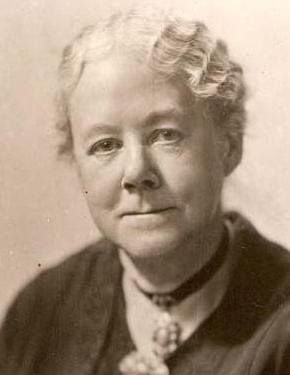‘To me has fallen the happy task of sharing their gifts among our people. There is nothing so embarrassing as wearing as an ill-fitting halo—but a life one would not change for any other.’
Clara Ellen Grant OBE 1867-1949
Clara Grant, social education activist. c. 1920
Born in Wiltshire to a reasonably well-off family, Clara Ellen Grant was a pioneer of infant children's education. A social reformer, she set up the Fern Street Settlement in 1907 to feed and clothe poor and hungry children in the East End of London. She dedicated her life to tackling child poverty. While her farthing bundles led to her moniker of The Bundle Woman of Bow, Clara set up several pioneering initiatives that continue to this day including breakfast clubs, health visits and libraries.
Clara Grant, social educational activist
Clara was a believer in the power of education to improve people’s lives. Always wanting to teach, she initially began working with the Universities Mission in Central Africa but following the death of her fiancé there, she returned to England and completed her teacher training in Salisbury. Influenced by the work of Friedrich Froebel who invented the kindergarten, she considered; children’s health, physical development, emotional well-being, the environment, and other factors important.
Grant was strongly influenced by the Child-Centred Constructivist Approach to Early Childhood Education based on German educator, Friedrich Froebel’s, “Play Theory”. Froebel placed great value on child-led activity and believed teachers and educators should give children the freedom to explore, discover and create for themselves, whilst offering sensitive guidance. This school of educational thought also promoted the idea that early childhood learning is holistic and intertwined with the developmental progression of the child. Froebel also was a powerful influence in the pioneering theories of two of Clara Grant’s fellow contemporary educationalists, Maria Montessori and Rudolf Steiner, whose ideas shaped early childhood education as we know it in the 21st century. Although an admirer of Montessori’s system of education, Grant did not hesitate to express her views about how unrealistic it was to put it into practice in the resource-lacking, overcrowded and poverty-stricken classes in East London. Instead, she showed teachers how to create their own classroom tools and materials for children to learn through manual use, including card games, textiles, and objects for sorting.
Deciding to further her education, she moved to East London and was shocked at the amount of local poverty there, particularly among the young children who attended the school. Instead of ignoring the lack of education around her, she set out to do something about it. Achieving her dream of teaching, she became the head of a small school in the deprived area of Hoxton and advanced her own education through university extension courses and lectures at Gresham College.
Clara worked for a time at Toynbee Hall, a social settlement in Whitechapel. The settlement brought the rich and poor together in one place. Wealthy volunteers could bring donations, culture, education, and provide day care and healthcare to the underprivileged in the economically depressed East End. It was here that Clara was influenced to dedicate her life to working with the poorest children in a school in Brewhouse Lane, Wapping, then one of the most deprived areas of London.
A decade later, in 1890, she was appointed headmistress of All Hallows School in Bow, one of five small schools in the area, all of which were made of tin. In 1905, a new school was built for the children who went to the five tin schools. The new school was called Devons Road School and Clara was given the job of Head Teacher, moving to a terraced house in Fern Street which backed onto the school.
The Fern Street Settlement
Grant’s humanitarian principles were influenced by religious convictions, as much as by the liberal values that inspired many philanthropists and social reformers of her time. Many of whom (George Lansbury, Mary MacArthur, Emmeline Pethick-Lawrence and Sylvia Pankhurst) championed welfare and educational projects to improve the living conditions of people in the poorest areas of the East End of London. Although she did not define herself as a socialist, Clara Grant saw inspiration in the social worker and American activist Jane Addams. Clara was also inspired by the Christian socialist ideas of Henrietta and Samuel Barnett, founders of Toynbee Hall and Oxford House. The pair settled in Whitechapel to improve social conditions and educate men and women in hopes of creating a class-less society.
Farthing Bundles
Clara started her own house, asking friends to donate old clothes and house items to be cheaply sold to neighbours. In 1907, it became to be known as the Fern Street Settlement, where women could learn a trade and children could be supplied with clothing and shoes. She gave hot breakfasts to her pupils, paying for the ingredients herself and with health volunteers provided healthcare, a dentist, a library and organised a thrift shop where donations of clothing, toys, beads, and games were given. With the items being of no practical use to the settlement, Clara came up with the idea of ‘Farthing bundles’ for children. Little parcels of toys, games and various other things were wrapped in newspaper and sold for a farthing with the money going back into the settlement funds. It earned her the affectionate nickname of the ‘Bundle Woman of Bow’. Queen Mary, Queen Elizabeth II’s grandmother, visited the settlement and afterwards sent some things from Buckingham Palace to help make up the Farthing bundles.
“Farthing bundles are full of very human things such as children’s love”
Farthing bundles for children continued well into the 1980s, as some of their beneficiaries still remember:
“I went also to the farthing bundles with my sister. We were always so excited to open the newspaper parcel, don’t matter what was in it”
“...Many of the children that lived in the area it was something to look forward to as there wasn’t many special treats. I remember there was always a comic, maybe a broach and little toys mostly broken. But it was always good to get and a really good memory. Thanks to that wonderful caring lady”
(Extracts from comments by people who attended the FB).
Poverty stricken children queuing for their farthing bundles. Image credit unknown.
Grant collected these pivotal guidelines for teachers of young children in a number of articles and books, published between 1917 and 1919. These contained progressive course of exercises and ideas on practical classroom activities, including innovative multi-sensorial exercises, songs and manual activities. Her most significant publication was The Teachers Book of Toy Making With Suggestive Courses of Occupation Work In Various Materials, published by Evans Brothers in 1917 and 1919, which had editions until 2017.
The Teacher’s Book of Toy Making With Suggestive Courses of Occupation Work In Various Materials by Clara E Grant. Image credit unknown.
In 1930, she wrote two autobiographical and self-published works to raise money for her educational and philanthropic work: ‘From 'Me' to 'We': Forty Years on Bow Common’ and ‘Farthing Bundles’.
For her work and service, Clara received an OBE in 1949 when she was 81 from King George VI. She died soon after and a huge number of people attended her funeral. Buried in Tower Hamlets Cemetery, half-a-mile from the Fern Street Settlement, her gravestone is in the shape of an open book.
The Farthing bundles initiative continued until its demise in 1984 but Clara’s vision lives on today. In 1993, the Devon Road School she had such an influence on was renamed the Clara Grant Primary School in her honour and in 1993 Clara was recognised by the London Borough of Tower Hamlets for all her work and a purple People’s Plaque was placed on the wall outside the Settlement in Fern Street. The same year, the Fern Street Settlement relaunched its work with children and families in partnership with All Hallows Bow Church, and in 2019 the project took on a new name, The Fern Street Family Centre, and provides pensioners with a day centre, a lunch club, and a place for adult education classes.
ABOUT THE AUTHORS
Jayne Mead is a London fiction writer interested in women’s history. https://jlmeadauthor.com/
Matilde Gallardo is a lecturer and researcher with an interest in women’s social history. matilde.gallardo@outlook.com
Sources:
https://en.wikipedia.org/wiki/Clara_Grant
https://claragrant.boleyntrust.org/our-school/history-of-the-school/
https://romanroadlondon.com/clara-grant-bundle-woman-bow/
https://the-east-end.co.uk/tag/clara-ellen-grant/
http://newidealsineducation.blogspot.com/2018/09/clara-grant-and-new-ideals.htm








